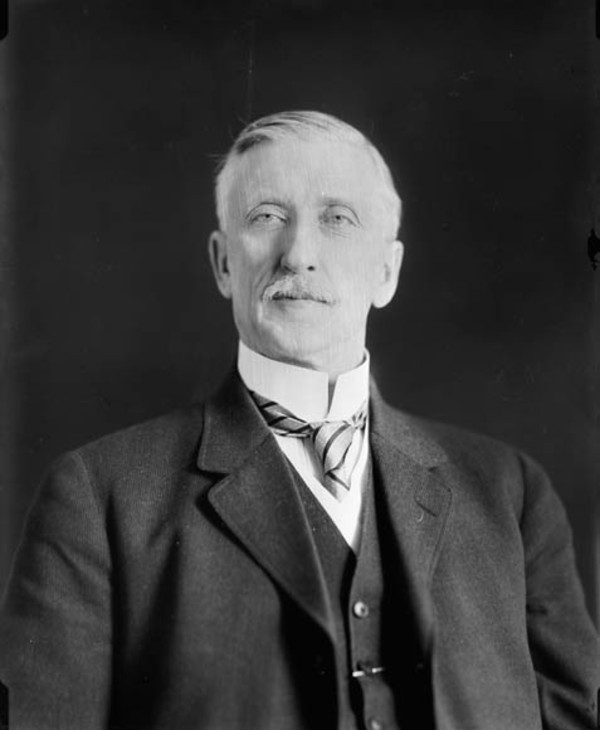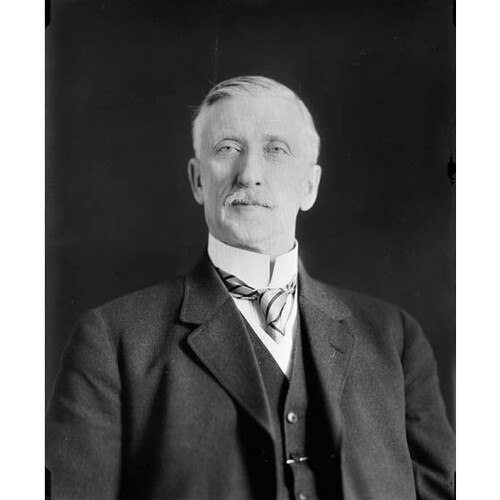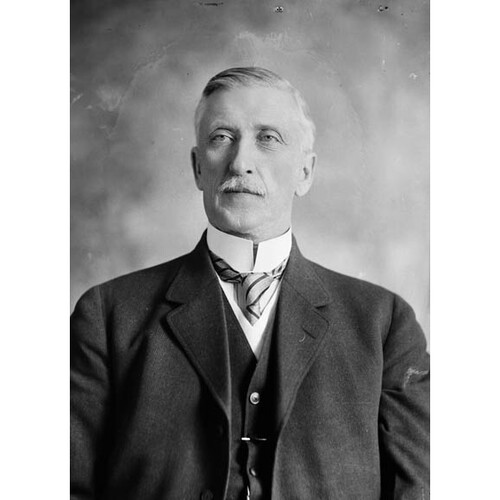COCHRANE, FRANCIS, businessman and politician; b. 18 Nov. 1852 in Clarenceville (Saint-Georges-de-Clarenceville), Lower Canada, second son of Robert Cochrane, a farmer, and Mary Ann Hunter; m. 16 Aug. 1882 Alice Lavinia Dunlop (Dunlap) in Pembroke Township, Ont., and they had two sons and a daughter; d. 22 Sept. 1919 in Ottawa.
The details of Frank Cochrane’s first 40 years are obscure. A son of Methodist parents, he was educated in the separate school at Saint-Thomas-de-Foucault (Noyan). According to family lore, he worked for a time in a department store in Chicago but was fired after a fist-fight with his supervisor. In the late 1870s he ended up in his maternal uncles’ general store in the Ottawa valley lumbering community of Pembroke. He soon joined the local hardware business of Dunlop and Chapman, and in 1882 he married Alice Dunlop. The couple moved upriver to Mattawa, where Frank took charge of a new branch of the company. He prospered enough to establish his own hardware and mining supply store in Sudbury, the emerging nickel-copper centre of northeastern Ontario; he located there in the fall of 1890, with Alice and their children joining him a year later.
Cochrane parlayed his store into Cochrane Hardware Limited, described at his death by the Sudbury Star as “one of the largest commercial institutions of its kind in the province, with branch stores all over the North Country.” An early reflection of his success was the completion in 1894 of the Cochrane Block, an imposing, three-storey brick building. Cautioned that it was too grand for the struggling town, he remained optimistic; 20 years later he would preside over the opening of an even more impressive headquarters in a considerably bigger Sudbury.
As Cochrane became established, he diversified his activities. One of his most profitable investments was in hydroelectricity. In 1902 he and local prospector William McVittie incorporated the Wahnapitae Power Company to develop generating sites. Two years later it won the contract to supply Sudbury, and it would continue to do so until 1929, when the Cochrane family sold its shares to the Hydro-Electric Power Commission of Ontario for more than $1 million. Again in partnership with McVittie, Cochrane speculated in various mineral properties, the most valuable being the so-called Frood Extension, purchased in 1908 and sold to the Mond Nickel Company in 1910 for $200,000.
As successful a businessman as Cochrane was, his historical significance lies primarily in his political career. A lifelong Conservative – family members recalled hosting Sir John A. Macdonald* in Mattawa – Cochrane was appointed Sudbury’s enumerator for the 1891 census, a patronage plum reserved for the party faithful. One of the “company of 100 associates” who successfully petitioned Queen’s Park for the incorporation of Sudbury as a town in 1892, he rose to greater prominence three years later, when he headed the organization of the local agricultural society and board of trade. In January 1896 he formally entered municipal politics by winning a seat on council for the predominantly English-speaking ward of McCormick. He served three terms as mayor (1897, 1898, 1902), each time defeating his Liberal critic, James A. Orr, editor of the Sudbury Journal. Competent and highly regarded, Cochrane stressed growth, accommodation with the area’s mining powers, and fiscal responsibility, policies very much in line with his business interests.
Cochrane ventured beyond municipal politics in 1902, when he contested the new constituency of Nipissing West in the provincial general election. With some justification, based on the poll results, he attributed his defeat to the advantage of the bilingual Liberal candidate, Joseph Michaud, in the riding’s French-speaking sections. The experience nevertheless proved valuable since it drew him into official party circles and brought his organizational skills to the attention of Conservative leader James Pliny Whitney.
Although active behind the scenes, Cochrane did not run in the election of January 1905, in which Adolphe-Osias Aubin defeated Michaud. Within days, however, rumours began to circulate that premier-designate Whitney intended naming Cochrane to his cabinet as spokesman for northern Ontario, possibly as minister of a new portfolio (mines). In February an accident delayed the appointment: when boarding a moving train near Sudbury, Cochrane slipped and his right leg was severed below the knee. His rehabilitation took several months. In May Whitney announced the conversion of the crown lands portfolio into a new department, Lands and Mines (later Lands, Forests, and Mines). Cochrane was sworn in as minister at the end of the month; the deputy minister continued to be Aubrey White. On 13 June Cochrane was returned by acclamation in a by-election in Nipissing East, its member, Charles Lamarche, having resigned in a move that may have been prearranged. Cochrane’s appointment was received with scepticism by the press in southern Ontario. The Liberal Globe of Toronto, for example, commented that he had no legislative experience and no “wide-spread prominence in any other sphere of activity.”
Cochrane’s six years as minister, though not without controversy and some failures, would be the most satisfying period of his political career. From the outset he was determined to play an aggressively interventionist role in the management of Ontario’s natural resources. Shortly after taking office, for instance, he cancelled five dormant pulp-and-paper agreements and put the concessions up for auction. Similarly, he rescinded a number of unworked claims being held on speculation by invoking a little-known section of the Mines Act that required proof of a mineral deposit. His most enduring accomplishments were the new Mines Act, approved by the legislature in April 1906, and the related Supplementary Revenue Act, passed a year later.
The product of extensive public consultation, the Mines Act was an attempt to meet miners’ demands for a more equitable system for exploiting mining lands. Emphasizing decentralization and uniformity, it divided the province into mining divisions, eliminated the leasehold system, and delineated a single and relatively inexpensive process for the acquisition of properties. Alarmed by the paucity of provincial revenues derived from the silver strikes in the Cobalt district, Cochrane, like Whitney, was determined to ensure that Ontario received the “people’s share” of the wealth generated by its mines. Particularly controversial was the provision in the revenue act for an annual tax on mining profits, the first in Ontario’s history. Mining companies lobbied furiously against the innovation. Under pressure, Cochrane agreed to change it from a flat to a progressive tax, making it more palatable to small firms. In the case of the Sudbury-based International Nickel Company, however, the change was privately offset by an agreement that temporarily circumvented the progressive clauses [see Almon Penfield Turner].
A consummate politician, Cochrane carefully tended his northeastern fiefdom – “Greater Ontario” he preferred to call it. Each summer he toured the region, building a Tory organization of considerable strength, often accompanied by cabinet colleagues or southern journalists. Government largesse in the form of colonization roads, railway subsidies, educational aid, and settlement assistance found its way to the area in ever-greater quantities. Particularly favoured was Sudbury, which in 1907 was designated the seat of a new judicial district; a year later, in part because of provincial assistance, it was linked to Toronto by both the Canadian Pacific Railway and the Canadian Northern. Political opponents charged that Cochrane was not above lining the pockets of his acquaintances, citing especially the government’s decision in 1906 to award $130,000 to his brother-in-law David Alexander Dunlap in the settlement of a mining-claim dispute at Cobalt. Cochrane’s political assiduity paid off handsomely in the election of June 1908. He was easily returned in his new constituency, Sudbury, and thanks in large part to his organizational ability, the party swept the other 10 northern ridings. Whitney immediately reappointed Cochrane to Lands, Forests, and Mines, and later, in gratitude, cabinet named the new town-site at the junction of the Temiskaming and Northern Ontario Railway and the National Transcontinental in his honour. (A northern township had also been named for him, in 1905.)
Cochrane’s growing reputation for organization led Robert Laird Borden*, leader of the federal Conservatives, to call on him to assist in the party’s Ontario campaign in the general election of October 1908. A tireless worker, he accompanied Borden on several swings through the province. The Conservatives won only the same number of seats there as in 1904, but there was a bright spot in northern Ontario, where, as a result of Cochrane’s efforts, the party’s representation increased from one to three of the four ridings. This involvement, an important step in Cochrane’s career, strengthened his ties to Borden and oriented him towards the federal arena. Perhaps for this reason and because major legislative changes had been made in 1906–7, his second term in the Whitney government was less consequential than his first. Its most notable accomplishment was the revision of forestry policy in 1910 to augment revenues.
In 1911 the highly contentious reciprocity agreement between the United States and the Liberal government of Sir Wilfrid Laurier heightened the likelihood of an early general election. As a result Cochrane’s exertions on behalf of the federal Conservatives increased substantially. His summer tour of his constituency extended to the rest of the province, and in August he was named chair of the party’s election committee for Ontario. In September the Tories made their long-awaited breakthrough, winning 73 of the province’s 86 seats (including all four in the north), a result Borden attributed to Cochrane.
In a manner reminiscent of the provincial scenario of 1905, Cochrane had not run in 1911, but with victory was to come a portfolio in the new government. He resigned from the Ontario cabinet in October. Once again a safe seat was found for him: George Gordon, the member for Nipissing, resigned (later to be elevated to the Senate) and Cochrane was speedily acclaimed. In Frank Cochrane, Borden had an mp of acumen and loyalty. His appointment to the Department of Railways and Canals was also an acknowledgement of the support tendered by Whitney’s provincial machine, although the new minister soon established that he was more than Whitney’s man in Ottawa.
Cochrane’s term as minister (1911–17) proved a good deal more frustrating than his years in the Whitney administrations. The labyrinthine politics of the quasi-public, quasi-private world of railways were trying, but doubly so when the folly of constructing two transcontinental lines (the Canadian Northern and the National Transcontinental/Grand Trunk Pacific venture), where the existing one (the Canadian Pacific) sufficed, was fast becoming apparent. From the outset Cochrane faced a series of seemingly unresolvable problems: the managerial troubles of the Intercolonial Railway in the Maritimes; the exorbitant construction costs of the government’s National Transcontinental, which were revealed by a royal commission in 1912–14 and which underlay the Grand Trunk’s refusal to lease the line upon its completion in 1915; the repeated petitions for financial assistance from the Grand Trunk/Grand Trunk Pacific tandem and the Canadian Northern; and the insistence of western Conservatives that Ottawa initiate the construction of the Hudson Bay Railway, a project Cochrane thought premature.
These issues had enormous financial and political implications for the government, and Cochrane’s ability to act was severely constrained by the views of his ministerial colleagues and the prime minister. He shared the concern of Borden and Minister of Finance Sir William Thomas White* over the plight of the Canadian Northern, and was much more antagonistic than the rest of cabinet towards the Grand Trunk conglomerate. Complicating his work too was the Liberal-controlled Senate, which, several times in 1912–13, defeated measures coming from his department, for instance a plan to provide assistance to the provinces for developing Canada’s highway system.
Efforts by Cochrane to deal with the perplexing rail situation were thrown into disarray in 1914 by World War I, which diverted financial and political resources away from railways. At the same time, by intensifying competition among the three transcontinentals, the war exacerbated the financial difficulties of the Canadian Northern and the Grand Trunk, and forced the prime minister to move toward nationalization, essentially taking the matter out of Cochrane’s hands. In May 1916 White announced temporary assistance to the CN and the GT; the following month a royal commission was appointed to make recommendations on Canada’s railways. Businessman that he was, Cochrane was not particularly enthusiastic about the majority recommendation delivered in May 1917 in favour of government acquisition of the two troubled railways, but like many of his cabinet colleagues he went along with it as the best option.
Not surprising for someone in his sixties, deteriorating health limited Cochrane’s activities during the war. In late 1913 he had had a nervous breakdown which required hospitalization, followed by a Mediterranean cruise in the spring of 1914. As well, he began to suffer the debilitating effects of Bright’s disease and had to take extended leaves. Worrisome too was the fact that his sons were overseas with the Canadian Expeditionary Force. A visit to the Western Front in the winter of 1915–16 aggravated his health and spawned rumours the following summer of his resignation.
Despite everything, Cochrane remained on the job, largely out of loyalty to Borden, who valued but did not necessarily follow his advice. A case in point occurred in the spring of 1915, when the ever-partisan Cochrane urged the prime minister, without success, to take advantage of the government’s popularity and call a wartime election. Predictably, Cochrane welcomed Borden’s announcement of conscription in May 1917 but he strongly opposed his efforts to form a coalition with the Liberals the following summer. It was somewhat surprising that Borden included Cochrane as a minister without portfolio in the Union government created in October. The explanation lay in part in the bonds between the two men and partly in Borden’s desire to retain Cochrane’s organizational skills for the upcoming election. Cochrane’s health did not permit him to play more than a secondary, advisory role in this campaign though he himself was easily returned in December for the new riding of Temiskaming.
Cochrane’s last years were especially unhappy. Convinced, probably with good reason, that Borden had promised him the chair of the board created to manage the government-owned railway system, including the recently nationalized Canadian Northern (but not yet the Grand Trunk), he was embittered in September 1918 when David Blythe Hanna* was nominated instead. Cabinet had reportedly been divided on the appointment, with Borden arguing that Cochrane’s health would not have stood up to the task. Compounding Cochrane’s devastation was the death of his younger son, Ogden Dunlap, in January 1919 from injuries sustained in a military training accident. Cochrane never recovered from the loss. Greater Ontario’s first, and some would argue greatest, politician died on 22 September in Ottawa. He was buried beside Ogden in Mount Pleasant Cemetery in Toronto.
Frank Cochrane was an exceptional individual, full of contradictions. By popular consensus a mild-mannered man, the six foot three inch hardware merchant was prepared to use physical force if necessary: according to Montreal financier Sir Herbert Samuel Holt*, Cochrane “could clean out a drunken sleeping car quicker than anyone I’ve seen in my life.” A chauvinistic booster of the north, he used his influence to further the regional ambitions of Sudbury, his place of business, but he never actually owned a home there or anywhere else in the region. A partisan of the first rank, he angered fellow Conservatives by refusing to dispense patronage blindly. A master electoral strategist, he never contested the same constituency twice. An unpretentious merchant from the backwoods, he became the trusted confidant of a premier and a prime minister. Most remarkable of all perhaps, he was a politician and a minister who spoke so sparingly in parliament that he earned the sobriquet Silent Frank. Canadian politics have seldom seen the like of him since.
[A barrier to researching the life of Frank Cochrane is the absence of personal and professional papers of the sort usually left by political figures of his stature. In preparing their biography, Silent Frank Cochrane; the north’s first great politician (Toronto, 1973), a thorough study upon which this entry relies for factual detail though not interpretative thrust, Scott and Astrid Young gleaned information from sources such as the House of Commons Debates, the Whitney papers in the AO (F 5), the Borden and White papers in the NA (MG 26, H and MG 27, II, D18 respectively), and the Sudbury Journal (Sudbury, Ont.). Of special interest because of the foreword by George W. Yates, Cochrane’s long-time executive secretary, is The Honourable Frank Cochrane: a tribute, comp. Alice [Stinson] Marwick ([Cochrane, Ont., 1950]). r.m.b.]
ANQ-E, CE2-75, 13 mars 1853. AO, RG 80-5-0-111, no.10251. INCO Arch. (Sudbury), Material relating to Francis Cochrane. Sudbury Star, 1910–19, esp. 24, 27 Sept. 1919. R. L. Borden, Robert Laird Borden: his memoirs, ed. Henry Borden (2v., Toronto, 1938). R. C. Brown, Robert Laird Borden, a biography, (2v., Toronto, 1975–80), 1. Charles Dorian, The first 75 years; a headline history of Sudbury, Canada (Ilfracombe, Eng., [1959]). J. A. Eagle, “Sir Robert Borden and the railway problem in Canadian politics, 1911–1920”
Cite This Article
R. Matthew Bray, “COCHRANE, FRANCIS,” in Dictionary of Canadian Biography, vol. 14, University of Toronto/Université Laval, 2003–, accessed April 25, 2025, https://www.biographi.ca/en/bio/cochrane_francis_14E.html.
The citation above shows the format for footnotes and endnotes according to the Chicago manual of style (16th edition). Information to be used in other citation formats:
| Permalink: | https://www.biographi.ca/en/bio/cochrane_francis_14E.html |
| Author of Article: | R. Matthew Bray |
| Title of Article: | COCHRANE, FRANCIS |
| Publication Name: | Dictionary of Canadian Biography, vol. 14 |
| Publisher: | University of Toronto/Université Laval |
| Year of revision: | 1998 |
| Access Date: | April 25, 2025 |





